
Manufacturer's Specifications:
Frequency Response: 5 Hz to 20 kHz.
Dynamic Range: Greater than 90 dB.
Channel Separation: 90 dB at 1 kHz.
Harmonic Distortion: 0.006% at 1 kHz.
Output Level: 1.4 V.
Headphone Output: 15 mW at 8 ohms.
Number of Programmable Selections: 16.
Power Consumption: 35 watts.
Dimensions: 13 1/4 in. (33.5 cm) W x 5 1/2 in. (14 cm) H x 10 5/8 in. (27 cm) D.
Weight: 15 lbs. (6.8 kg).
Price: $699.95.
Company Address: 1200 West Artesia Blvd., Compton, Cal., 90220, USA.
Sanyo has chosen to configure their first CD player as a front-loading machine with a hinged door which swings open to accept the disc. An automatic loading mechanism then closes the door, orienting the disc vertically for playing.
The player features one of the most elaborate display arrangements I have encountered in any CD player to date. A real-time counter display can be set to show the time from the beginning of a given musical selection, or total time elapsed from the beginning of the disc being played. "Multi Display" readout shows "Music No." (track number) and either "Index No.," "Next No." (when multiple selections have been programmed for sequential play), or "Program No." Up to 16 selections may be programmed into the memory of the DAD 8, so you can listen to that many tracks (or track and index combinations) in any order you choose.
There is also a repeat-play function.
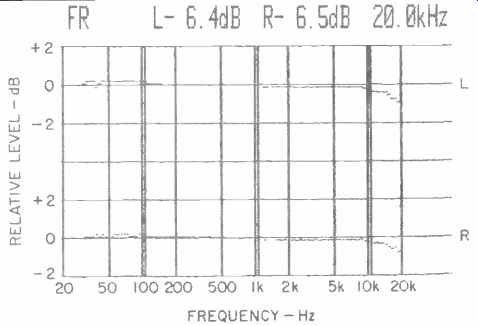
Fig. 1-Frequency response, left (top) and right channels, at 0-dB (maximum)
level.
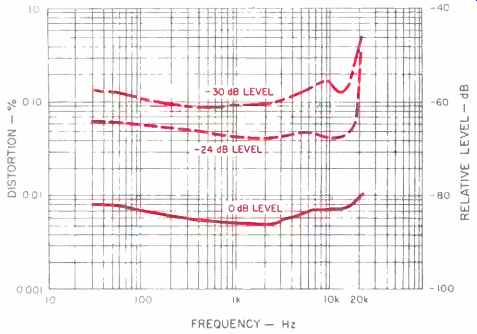
Fig. 2-THD vs. frequency at levels of (top to bottom) - 30.- 24 and 0 dB.
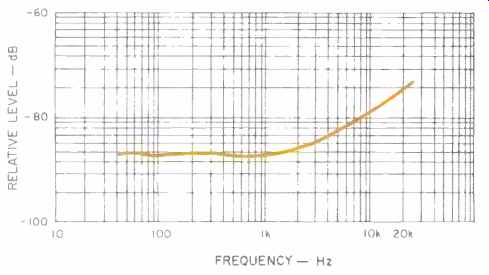
Fig. 3--Channel separation vs. frequency.
Control Layout
The power on/off button is at the upper left corner of the front panel, near the disc-compartment door which occupies fully one-half the panel's width. The "Real Time Counter" and "Multi Display" readouts are just to the right of the disc door, one above the other. The "Multi Display" mode is indicated by three labeled LEDs just below the readout, for use in setting up selection programs. Ten numeric keys, used for programming track and index numbers, are just below the displays.
At the top of the right-most section of the panel are the "Open/Close" touch button, which controls the door, and two more buttons which set the real-time counter to display either the time from the start of the current selection or total time from the beginning of the disc. Below are the main function controls: "Back Access" and "Fwd Access" (which move the laser pickup back to the start of the current selection or ahead to the start of the next one), plus the standard "Play," fast reverse, fast forward, "Repeat," "Stop" and "Pause" functions.
Pushbuttons associated with programming are located at the lower right of the front panel. The "Memory" switch stores selected program or index numbers and recalls memorized selections in the order in which they are to be played, "Memory Clear" removes memorized selections (one at a time), "Program Clear" erases an entire memorized programming sequence, "Recall" will call up program contents in reverse order (from last to first), and "Program Play" initiates play of programmed selections. Also located in this area of the panel are a "Program Write/Display" button (which selects the mode for the multi-purpose display), a stereo headphone jack, and a headphone output-level control. The rear panel of the DAD 8 is equipped with a single pair of stereo output jacks. This unit does not have an overall output-level control.
Measurements
Figure 1 shows measured frequency response for both left and right channels of this Sanyo player. Evidently, in the sample I tested, the multi-pole, low-pass filter component tolerances were a bit off, for, as the notation above the response plots shows, response at 20 kHz was down 6.4 dB for the left channel and-6.5 dB for the right. Note, how ever, that at the spot frequency just below 20 kHz (which happens to be 18.5 kHz on my test instrument), response was down a little less than 1 dB.
Harmonic distortion at mid-frequencies, for a maximum recorded level, measured 0.0055%, rising to 0.008% at 41 Hz (the lowest continuous test frequency on the Philips test disc) and to a comparatively high 0.1% at the highest test frequency available (19,997 Hz). The relative distortion levels remained the same at lower recorded levels. As shown in Fig. 2, distortion measured 0.045% at mid-frequencies for a-24 dB recorded level, rising to 0.065% at 41 Hz and 0.35% at the highest test frequency. The distortion versus frequency curve exhibited a consistent shape at the still lower test level of-30 dB below maximum recorded output.
Output linearity was accurate to within 0.2 dB from maximum output level down to-60 dB, and within 1 dB down to well below -80 dB. Stereo separation (Fig. 3) ranged from 86 dB at mid-frequencies to 73 dB at the high-frequency extremes. SMPTE-IM distortion was a very low 0.0025% at 0-dB output level, increasing to 0.03% at a-20 dB recording level.
Plots of residual noise were made using the facilities of my Sound Technology 1500A tester. Results for both un-weighted and weighted S/N are shown in Figs. 4A and 4B.
Overall unweighted S/N was 94.8 dB; using an A-weighting network, S/N measured exactly 100 dB below maximum recorded level.
Examination of a reproduced 1-kHz square wave (Fig. 5) and a unit pulse (Fig. 6) reveals that Sanyo uses an analog multi-pole filter after D/A conversion, as opposed to a digital filter. This is the same approach followed by many manufacturers (including Sony, Hitachi, Sharp, and Toshiba). Phase relationships between the 2-kHz left-channel signal and the 20-kHz right-channel signal shown in Fig. 7 are typical of those obtained for other CD players employing this type of filtration. Had there been no phase displacement between the two signals, both would cross the zero axis in the same (positive-going) direction at the same time. Here we see a half-cycle error at 20 kHz (about a 25 µS delay), but actual error could be higher by a multiple of 360°, for reasons explained in the Sears CD test in this issue.
Using the specially prepared Philips tracking and error-correction disc, I determined that the DAD 8 was able to play through the entire opaque wedge, applied to the disc's surface, which simulates scratches of increasing severity. In other words, the error-correction level built into the DAD 8 was able to correct or substitute for "missing" data that extended over a linear distance of 900 microns or better. On the other hand, confronted with a black dot (simulating dirt particles) of 600-microns diameter, I detected muting of the disc's program material. As for the fingerprint-smudge simulation, the player's tracking system and pickup were able to ignore it entirely.
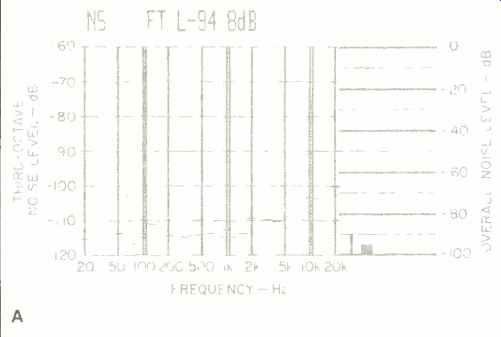
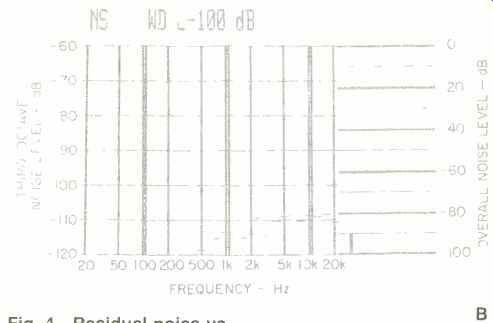
Fig. 4--Residual noise vs. frequency, unweighted (A) and A-weighted (B).
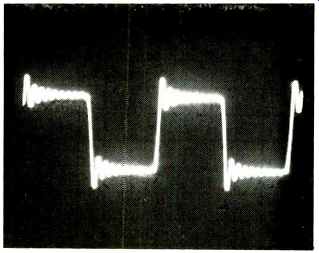
Fig. 5--Reproduction of 1-kHz square wave.
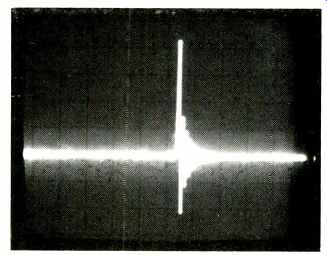
Fig. 6--Single-pulse test.
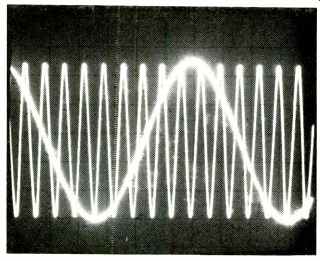
Fig. 7--Phase linearity test, 2- and 20-kHz signals.
Use and Listening Tests
The Sanyo DAD 8 has excellent programming capabilities and offers rapid access to any desired track or index. I would hope that, sooner or later, some standards of nomenclature will be set up for CD players and discs. I found it a bit confusing, at first, that Sanyo refers to what I (and others) have been calling a "track number" as a "music number." Adding a bit more to the confusion is Sanyo's referring to the programmed selections as "program number," which many might interpret as meaning track number as well. In other words, Sanyo calls the individual musical selections found on a disc "music numbers," while the sequence of programmed instructions you, the user, feed into memory are designated by Sanyo as "program numbers." I can't fault Sanyo for choosing such designations; they're probably as valid as some of the other descriptive terms that have been used. I simply wish that all manufacturers would get together on what to call these items. About the only one that everyone seems agreed upon is "index," the subdivision within a track ("music program"?) that is digitally identified in only a few of the currently available CDs.
The Sanyo player did well in its ability to withstand minor shocks or tapping of the surface while maintaining proper tracking. Sound quality was not substantially different from that observed with other CD players employing steep-analog, post-D/A filters. While some have criticized this particular circuit approach, I have not found it objectionable, though I can now clearly discern the difference in reproduced sound between players that employ this type of filtering and those that use digital filtering and oversampling.
My disc collection continues to grow, and I was particularly delighted with the way Telarc's CD of Beethoven's Third Piano Concerto (Rudolf Serkin at the keyboard, with the Boston Symphony conducted by Seiji Ozawa) sounded when played on the Sanyo DAD 8. Other recent additions to my collection which did well were a Philips CD of Schubert's Fourth and Fifth Symphonies (Neville Marriner conducting the Academy of St. Martin-in-the-Fields Orchestra) and a CBS Masterworks recording of the late Glenn Gould playing Bach's Goldberg Variations. Needless to say, all three of these recordings are "digital" from start to finish, as op posed to many CDs in my collection which are remakes of recordings from analog open-reel master tapes. I have nothing against transferring musically worthy performances from analog master tapes to Compact Discs (the results are usually better than what could be obtained in an LP version), but I feel that I am better able to distinguish minor differences between CD players when the source material is digital all the way through.
To sum it all up, the Sanyo DAD 8 has a great deal of programming versatility and flexibility. Its front-panel functions are easy to understand and use once you read the owner's manual through at least once (it's only 10 pages in length, counting the front cover and the published specification page). Sound quality is much like that of other players using similar circuitry. I liked the fact that it is necessary to touch the "Open/Close" button to load a disc into the compartment drawer, for I've always been somewhat intimidated by those mechanisms which just about grab the disc out of your hand and swallow it up inside the door, ready or not. Sanyo's approach to disc loading is a bit less frenetic and more reasonable, in my opinion.
-Leonard Feldman
(Audio magazine, April 1984)
Also see:
Sears 564.97500350 CD player (April. 1984)
Sharp DX-3 Compact Digital Audio Disc Player (Mar. 1983)
= = = =